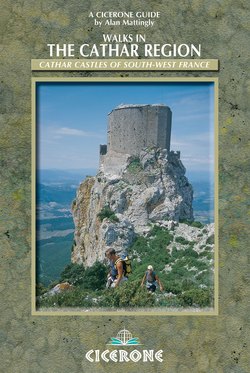Читать книгу Walks in the Cathar Region - Alan Mattingly - Страница 12
На сайте Литреса книга снята с продажи.
ОглавлениеPREFACE
The Cathars were a dissident sect of medieval Christians. They enjoyed widespread support in what is today southern France. In the 13th century they were brutally suppressed and took refuge in hilltop fortresses, known today as ‘Cathar castles’.
Those castles are set in an area of beautiful countryside which offers excellent walking opportunities. It is a varied, challenging and fascinating region, enjoying plenty of sunshine and rich in wildlife. It has plentiful reasonably priced accommodation and abundant opportunities for wine tasting and gastronomic delectation.
The region is today one of France’s most popular walking areas, but it was not always so – most of the walking routes in Cathar castle country seem to have been developed in relatively recent times. For example, when the traveller and author Nicholas Crane passed through St-Paul-de-Fenouillet in the early 1990s on his epic mountain walk across Europe, he was told that he was in the ‘dead zone’, where tourists were rarely seen, even in high summer. Today St-Paul is close to new waymarked walking routes, which pass beneath Quéribus and other Cathar castles. It is now frequented by walkers and visitors from many parts of Europe and beyond.
It seems that everyone who tours this stunning countryside and reads about the tragedy of the Cathars is moved by the landscape and by that story. Many are also gripped by the several legends that surround the Cathar castles – of buried treasure, the Holy Grail, sun worship, and contemplative ladies dressed in white who had an unfortunate knack of precipitating disaster.
This book concentrates mainly on the walks, the landscape, and the history of the Cathars’ downfall. But, insofar as any lesson is drawn from this tour of a region that witnessed the crusade against the Cathars (and which, like most of Europe, also suffered two millennia of almost constant combat), that lesson is touched upon lightly in the final chapter. Entirely devoid of originality, that conclusion is at least brief. It is – quite simply – give peace a chance.
For that reason (among many others), this book is dedicated with gratitude to two lifelong campaigners for peace of my close acquaintance, namely my parents Pat and Alec Mattingly.
Alan Mattingly, Vernet-les-Bains
Like many Cathar castles, Lordat castle towers above its village (Section 6)
